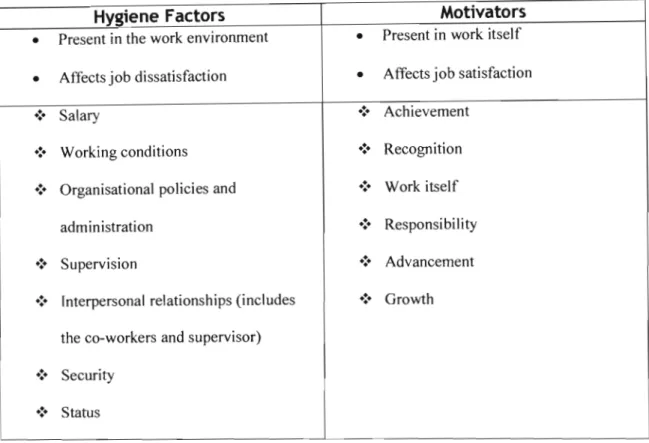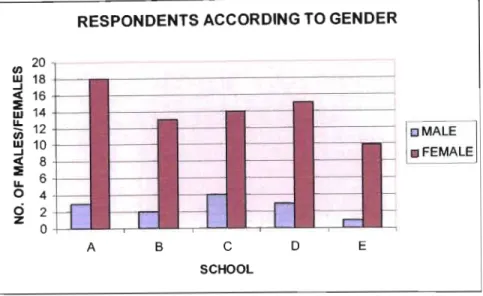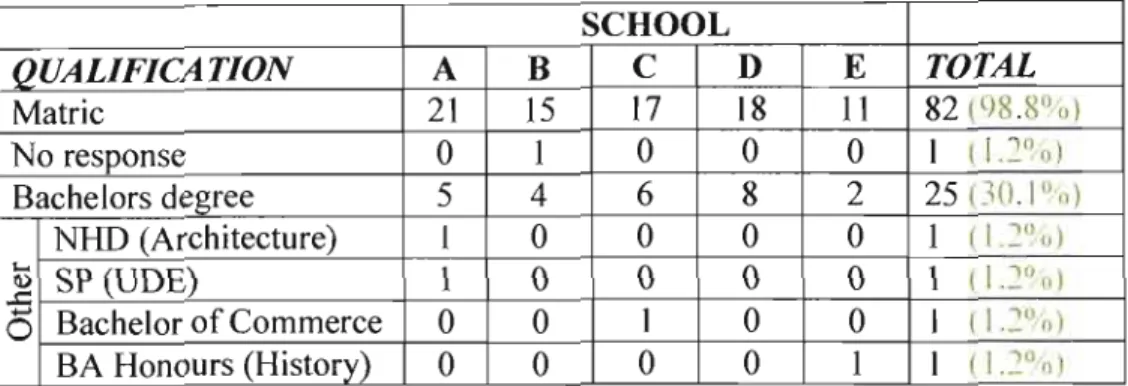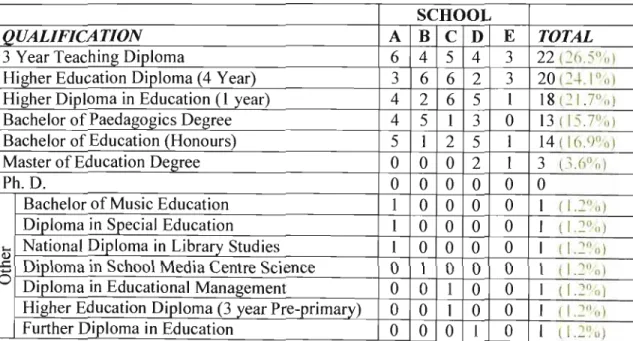The principals and staff of the sample schools whose cooperation made this research possible. However, for the purpose of this study, an analysis of some theories will be conducted. The researcher chose to use the questionnaire because it has fewer bias possibilities.
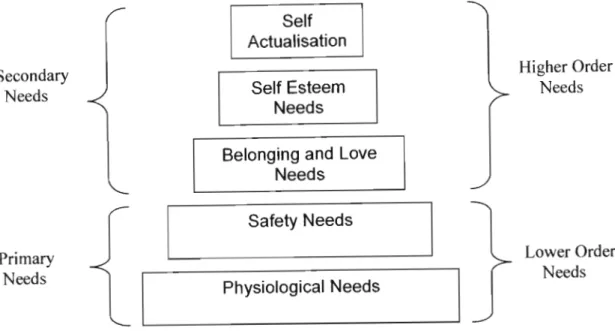
The table on the previous page shows that 33.7% of respondents had not been at their school for more than five years and 65.1% of teachers had been at their school for more than six years. The answers also show that 1.2% of teachers had been at their school for more than 26 years. The findings show that a significant portion (66.3%) of the teacher group had been in school for more than six years.
Moreover, the lack of motivation cannot be attributed to the lack of teaching experience of the teachers in their current schools.
Post occupied by educator
Furthermore, to elaborate on the task of school managers to motivate educators, Gannon, as cited by Bondesio and de Witt, makes the following observation: "Management activities such as planning, organizing and decision-making are dormant cocoons until the leader activates the power of motivation . in people and lead them to their goals." The overarching perception of the majority (86.7%) of respondents from the sample schools was therefore that school managers should be responsible for the motivation of educators.
Educators perceptions of how school managers could motivate them
In addition, most respondents point to a concern for people-related strategies rather than the technical aspects of their work. From the responses, 12% of the sample of educators indicated that they were highly motivated, 48.2% considered themselves to be motivated, 35% indicated that they were demotivated, 2.4%. Despite the many challenges they experienced, a significant proportion of these educators (60.2%) were still motivated.
The responses show that 13.3% believed that the teachers in their schools were highly motivated, 32.5% believed that the majority of the teachers in their schools were motivated, 34.9% felt that the teachers at their schools were demotivated, 14.5%. From the responses, 73.5% of the teacher sample indicated that their school managers encouraged safe working conditions, while 21.7% thought otherwise, and 4.8% of those surveyed. The findings indicate that school managers at the sample schools attempted to meet the safety and security needs of their teachers, which Maslow believes is important if individuals want to move to the next level of the motivation hierarchy.
The graph above clearly shows that 83% of respondents felt part of their school. Thus, with 83% of respondents indicating that they felt part of the school, this means that a vital sense of belonging could contribute to one of the factors that could be related to teacher motivation in the sample schools.
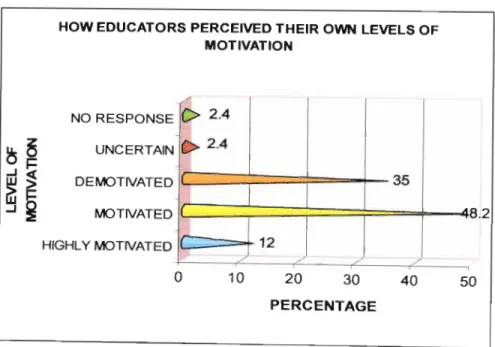
One teacher wrote that because of her performance she was encouraged to apply for the National Teaching Award in. From the responses, 42.2% believed that opportunities were not created for them to develop to their full potential, 53 % thought otherwise, indicating that opportunities were created for them to develop their full potential, and 4.8% of the educator committees did not answer the question. The results reveal that school leaders provided some teachers with opportunities to develop their skills and abilities to their maximum potential.
This implies that developing one's potential could have been a motivational strategy used by some school leaders in the sample schools. One educator commented that she was allowed to offer the local community a parenting workshop on Saturdays. The teachers were given the opportunity to act as head of department on a rotating basis (2.4%).
Among the answers, 56.6% thought their work was interesting, 20.5% thought their job was not interesting, and 22.9% did not answer the question. Thus, school leaders in the model schools were able to use challenging assignments as a means of motivating their teachers.
Does your school manager encourage team work?
Question 11: Supervision of work by school managers
From the above statistics, it was clear that the professional development of the educators was one of the factors that could be linked to the teachers' motivation at the trial schools. Based on the responses, 91.6% of the teacher committees agreed that their school leaders delegated tasks/responsibilities. Positive responses were received from 72.3% of the teacher sample, 25.3% responded negatively, and 2.4% did not respond to this question.
It appeared from the responses that setting realistic goals was one of the factors associated with teachers' motivation in Isipingo. This is because 66.3% of respondents indicated that the goals they were given were realistic, while only 32.5% were. Although more than half of the teachers (55.4%) indicated that they did not receive feedback on their performance, 60.2% of the teachers indicated that they were motivated, suggesting that it was not a significant problem in the teaching. factors associated with the motivation of teachers in the test schools.
Of the answers to the question that asked for a description of the feedback received by the educators, 68.8% stated that the feedback was regular, 31.2% did not answer the question. The table above shows that only 31.3% of the respondents think that rewarding or recognizing the contributions of educators to the school is fair, 45.8%.

VARIABLE RESPONSES
System of recognising and/or rewarding educators' efforts
The graph above shows that 80% of principals claimed to supervise the work of their educators at least once per term and 20% supervised the work of their educators at least once a week. These findings are similar to those obtained by educators who found that most educators' work was being supervised. This answer corresponds to the answers received from the educators where 91.6% of the educators agreed that the leaders of their schools have delegated tasks and responsibilities to them.
All the respondents (100%) indicated that they provide support to their educators when they delegate tasks to them. Although in the responses elicited from the educators' questionnaires, only 65.1 % indicated that some kind of support was provided to help them achieve their goals, the educator's response is significant enough to imply that support by the school managers were provided when educators were delegated tasks. . All the principals (100%) indicated that they did not have to force their educators to perform effectively.
A possible explanation for this is perhaps that selected educators were given feedback compared to all educators receiving feedback, hence the discrepancy in findings. Section C focuses on perceived demotivating factors for educators, challenges principals face in motivating their educators, and principals' perceptions of educators' motivation levels.
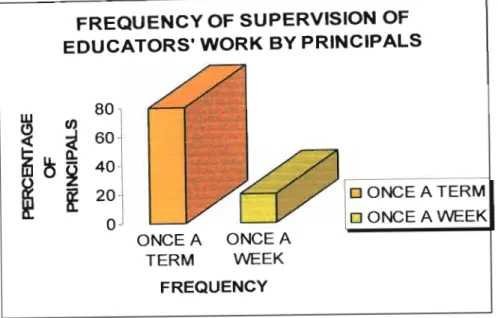
Question 2: Challenges faced by principals in motivating their educators
Question 1: Principals ' had to express any other views on educator motivation
The respondents had to indicate, when designing and implementing
80 percent of school leaders claimed to use praise and recognition of teacher performance as a motivational strategy. However, this differs significantly from the teachers' answers, where only 2.4% of the teacher committees stated that it was a motivational strategy used by school leaders. Teachers in schools B and D indicated that they were motivated by interpersonal relationships between themselves and the school leaders.
In School E, the educator felt strongly that school leaders should support and provide appropriate guidance for educators. 86.7%) of the sample of educators believed that school management should play a key role in motivating them. However, an alarming 63.9% of respondents (educators) revealed that their school management did not initiate strategies to motivate them.
Research question (3): What strategies do school leaders use in the test schools to motivate their teachers in their work. Although all principals in the sampled schools listed motivational strategies they claimed to use, 63.9% of the educator sample revealed that their principals had not implemented strategies to motivate them. Motivational practices as outlined by the school leaders indicate the lack of a sound integrative theory.
Furthermore, the majority of the educator sample felt strongly that the school managers should play crucial roles in motivating them.
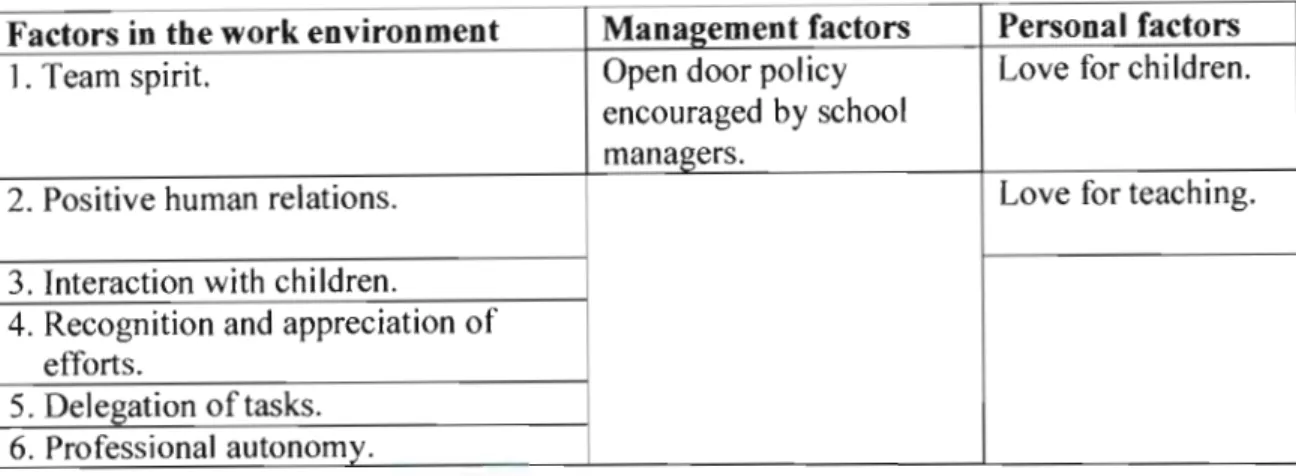
QUESTIONNAIRE FOR THE EDUCATOR SECTION A
BIOGRAPHICAL INFORMATION
Place a cross in the box that best describes the majority of educators in your school.
S ECT ION C
Does your school manager give you autonomy (freedom) to initiate your own strategies when completing a task? Is the system of rewarding or recognizing educators for their contributions to the school applied fairly.
SECTION D
Q UESTIONNAIRE FOR THE PRINCIPAL SECT ION A
BIOGRAPHI C AL INFORMATION
SECTION B
SECTION 0
- When designi ng and implementing motivation strategies, are they
- List s ome of the strategies that you employ at your school to motivate ed ucators
Share your experiences of how your school manager(s) motivated you in your work. I hereby request permission to carry out the aforementioned research study at the following 5 schools in Isipingo: [The names of the schools have been withheld to ensure anonymity]. The invaluable assistance of the staff and principal is required to complete the relevant questionnaires.
That you as a researcher must submit a copy of the written consent of the Department to the Head of the relevant institution before any research may be undertaken at a departmental institution, bearing in mind that the institution is not obliged to participate if the research a departmental project. Research must not be conducted during official contact time, as education programs must not be interrupted, except in exceptional cases with special approval from the KZNDoE. The research will be limited to the schools or institutions for which approval has been granted.
A copy of the completed report, thesis or dissertation must be provided to the RSPDE Directorate. Finally, you must sign the attached declaration that you are aware of the procedures and that you will comply with them.
K WAZU LU - NATA L
In conducting this research, I will ensure that normal learning and teaching is not disrupted and that all participants and your school remain anonymous. This study will at least provide insight into some of the theories and their managerial implications. In this study, all teachers and principals of the five selected schools in Isipingo are asked to complete questionnaires.
In addition to the above, teachers will be selected at each school to participate in a group interview. The selection of participants will be based on the number of years of teaching experience and gender representation. There will be an audio recording of the interview to facilitate the interview process.
To ensure anonymity, the names of the schools, principals and educators will not be required in the questionnaire or the interview. Although you remain anonymous, your perceptions and experiences form a vital part of the study and will be used accordingly.
